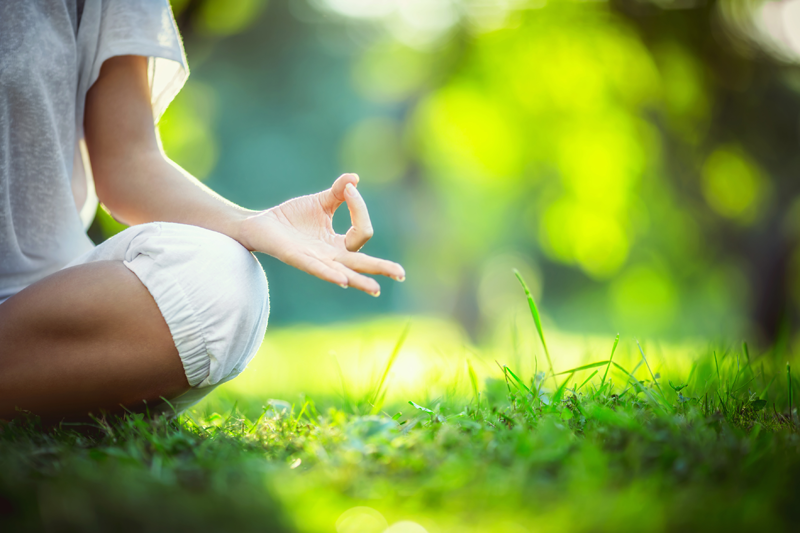If you’re a regular yogi, you’re probably familiar with the Yoga Sūtras and the eight limbs of yoga. In case you’re unsure, the Yoga Sūtras of Patañjali are a collection of Indian sutras on the theory and practice of yoga, focussing on the eight limbs. The name ‘eight limbs’ comes from the Sanskrit term, Ashtanga. In Sanskrit, ashta means ‘eight’ and anga means ‘limb’. The last three limbs, dharana, dhyana, and samadhi, focus on meditation. To connect with the divine, good meditation skills are essential. If you struggle with meditation, don’t panic. We’re here to help! In this article, we explore the visual meditations of artist and Sanskrit expert Melissa Townsend. It won’t be long before you pack your yoga bag and embrace the yoga sutras in a totally new way with these meditation practices.
Dharana, Dhyana and Samadhi
Most people find dharana fairly straightforward, but struggle when it comes to dhyana. Dharana can be translated to concentration or steadiness. With this limb, you take an object of meditation, such as a mantra, and focus on it. As long as you focus your full attention on the object, you can use anything that you like. Essentially, dharana is a surface state of mind so is relatively easy to achieve.
Dhyana, on the other hand, is the total opposite. The limb requires a lack of focus, lack of concentration and a lack of effort. In this limb, the object of meditation is non-discrete. To achieve dhyana, you need to understand Transcendental Meditation and how to practice it. Transcendental Meditation allows a yogi to achieve dhyana and reach samadhi – the final stage of meditation at which union with the divine is reached.
The Yoga Sūtras of Patañjali – A Visual Meditation
The Yoga Sūtras of Patanjali – A Visual Meditation, is a visual representation of Book One of the Yoga Sutras. Written and illustrated by Melissa Townsend, the full-colour art book contains beautiful and thought-provoking paintings for each of the sutras. Each piece has been created as a meditative guide in response to Townsend’s years of working with the Yoga Sūtras.
According to Townsend, the paintings are the results of her spiritual practice. She encourages readers to use the work to engage with each sutra, listen to their mind and ground themself. Many people use the art before meditating to bring a deeper meaning to the Yoga Sūtras. Each of the paintings comes with its own commentary, which we explore below. Start by reading through the commentary and chanting it a couple of times. Then, follow the link and let your eyes rest on the image for a few minutes. If you remember the commentary, you may like to chant it while you view the art, but this isn’t compulsory. Finally, shut your eyes and meditate, and notice what happens. Below, we explore the commentary from three of the Sūtras in Townsend’s book.
https://melissa-townsend.com/paintings
Sutra 1.9 Meditation
Sutra 1.9 should be used to ignite your imagination and encourage abstract thinking. This Sutra focuses on Vikalpa, which translates to ‘imagination’. In Patanjali’s definition of Vikalpa, he suggests that an idea or thought exists only via words. The idea has no actual substance or objective reality away from the words that describe it. Someone can say “a red-winged horse” and a clear image appears in your mind. However, there is no actual red-winged horse other than the image that the words created. The aforementioned red-winged horse is depicted in Townsend’s painting.
Vikalpa can also be translated as abstract thinking or conceptualisation. This can include metaphors or concepts like space, time or soulmates. It also includes the ways we categorise people, ideas and things to help us make sense of the world and give things meaning. Ultimately, all of these concepts are imaginary and a product of words.
Sutra 1.14 Meditation
Sutra 1.14 should be used to get inspired and commit to daily practice. When used over a period of time without interruption, your practice becomes firmly grounded. However, it’s important to have the right attitude and complete faith to achieve this. Abhyāsa is the Sanskrit word for practice. This Sutra expands the definition of the word and states that we must practice regularly and sincerely for it to be effective.
This artwork shows drops of water that drop to fill a pool until it becomes full. According to Townsend, the blue colour palette mirrors the blue pearl of meditation – a light that many people experience when meditating. The water drops represent the intentional and consistent work of quieting the mind.
While creating this piece, Townsend was inspired by an image of an underground reservoir created by the Fremen, the fictitious characters of a barren desert in Frank Herbert’s novel, Dune. Just like the reservoir created by the Fremen, our practice becomes deeper every time we put time into it. Eventually, it comes a metaphorical body of water that sustains us.
Sutra 1.35 Meditation
Sutra 1.35 should be used to explore your senses to connect with the Divine. When we meditate, subtle use of the senses created steadiness in the mind and helps us to focus. This can be used to achieve samadhi.
Patanjali believes that each of the senses can be a vehicle for subtle experiences that bring peace and steadiness to the mind. Over time, this can move you towards the final limb of yoga, samadhi – union with the Divine. Sometimes, experiences such as sounds, visions, tastes, smells and physical sensations appear naturally. Other times, they are the result of certain practices and techniques. These sensory experiences encourage peace and steadiness and can help us to practice Transcendental Meditation.
In Summary
So, there you have it – how to embrace the Yoga Sūtras in a totally new way with these meditation practices. To deepen your meditation practice, browse the paintings and techniques of Melissa Townsend. If you’re struggling to focus, you may benefit from some yoga jewellery. Certain pieces are designed to promote focus, concentration and overall calmness.

